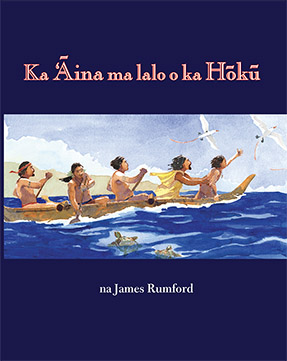What guides you?


To purchase a copy of Island below the Star, click here.
To purchase a copy of Ka ‘Āina ma lalo o ka Hōkū, click here.
Ka ‘Āina ma lalo o ka Hōkū: pehea i hele mai ai ka po‘e kahiko i Hawai‘i nei. Inā ‘oe e makemake e kū‘ai mai i kope ma ka ‘ōlelo Hawai‘i, e ho‘okui ma‘ane‘i.
For the last sixty years, we have witnessed the exploration of space. We view this as an expression of our American culture, the extension of a people who are the sons and daughters of pioneers and immigrants. Our space triumphs thrill us; our imaginations soar.
It is with this in mind that we must view the exploration and colonization of the Pacific by Oceanic peoples. To say that they wandered across the Pacific from island to island in search of food or political freedom is only part of the story, just as it is only part of the story to say that Columbus was solely motivated by commercial success or America was only peopled by religious refugees or that going to the moon was just an extension of the Cold War. But to say that Oceanic peoples explored the Pacific as an expression of their culture is to place an emphasis on the humanity of their endeavor.
Oceanic peoples built a culture around exploration. Exploration was a cultural imperative, a must. Legends and chants extolled the virtues of the ancient navigators. Genealogies recounted their triumphs. To the peoples of the Pacific, even the starry sky was a map to guide them as they set out to explore their world. For every star above, there was an island below. With this knowledge, they were convinced that they would reach land—as convinced as Columbus was when he sailed west or as we were when we pointed our rockets to the heavens.
How Pacific peoples covered vast stretches of the Pacific Ocean without modern navigational instruments is another important theme of the book. Each of the brothers becomes a symbol of the five elements of pre-modern navigation: Hōkū looks to the stars. Nāʻale to the Sea. ‘Ōpua to the clouds. Makani to the winds. And Manu to the birds. As symbols, they prepare five discreet spaces in the child’s mind to be filled in by further investigation and personal exploration. They become poetic figures recalling the days when all knowledge was concealed in poetry and when the keys to the ancient mysteries could only be understood by the hard lessons of experience.
Island below the Star is not a retelling of an ancient legend. The five brothers did not exist. They are symbols of the past and the present. They tell the ancient story of exploration. They shed light on a modern saga of rediscovering the ancient ways. They remind us of one of the greatest triumphs of the human race: the peopling of Oceania.

